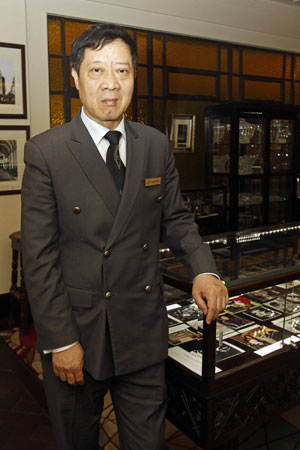People
A lifetime of service
Updated: 2011-05-18 08:24
By Tiffany Tan (China Daily)
|
 Ma Yongzhang, director of the Peace Gallery, has been with the hotel for 47 years. Yong Kai / China Daily |
The director of the Peace Gallery, the small museum of Shanghai's Fairmont Peace Hotel that reopened last summer, recalls his love affair with the iconic hotel. Tiffany Tan reports.
Ma Yongzhang gladly gave up a retiree's leisurely life to be reunited with his most enduring love: Shanghai's iconic Peace Hotel. Ma first entered the hotel's storied halls as a 16-year-old elevator operator in the spring of 1964. The next four decades saw him become closely acquainted with the five-star hotel's inner workings through posts like room attendant, gift shop clerk, front desk cashier, hotel assistant manager and director of housekeeping.
He was public relations manager when the hotel closed in 2007 for what would be three years of renovations, under the Fairmont Hotels and Resorts brand.
Ma, who was then 60, decided to retire. But it was like parting with a close family member who had seen him through adolescence, adulthood and middle age.
"Every time I went past, I would look at the hotel," Ma says in his British-accented English, referring to the hotel's prime location at the corner of The Bund and Shanghai's tourist mecca Nanjing Road. "I paid quite a bit of attention to any report in the newspapers about the hotel I would clip and keep them.
"When the general manager asked me to come back, I immediately accepted. At the time, they didn't pay me so much but I didn't mind. I just wanted to work for the hotel."
Ma, who favors double-breasted jackets, is now director of the Peace Gallery, the small museum in the Fairmont Peace Hotel, that reopened last summer.
"The (hotel) owner believes he is the best candidate for director of the Peace Gallery," says Chen Xiuyan, the hotel's marketing communications coordinator. She explains that even while serving as public relations manager, Ma was "in charge of the Peace Gallery since 2006 to collect all the historical pictures and memorabilia".
As the hotel's longest-serving employee, few positions could have been more suited for Ma, whom foreign guests know as Martin. He's been around for more than half of the hotel's 82 years of existence.
The second and last Wang-Ku Meeting between representatives of the Chinese mainland and Taiwan, since their 1949 split, took place at the hotel on Oct 14, 1998.
"A lot of journalists came and took photographs, about 200 journalists," Ma says, pointing to a picture of the historical meeting, on display in the gallery alongside works for its just-concluded exhibition on "Famous People in Cathay to Peace".
The title alludes to the hotel's birth in 1929 as the Cathay Hotel, the brainchild of its original owner Victor Sassoon, a member of the British aristocracy who found fame and fortune in Shanghai real estate.
"This is one of the most luxurious hostelries in the world, rivaling the best in Manhattan and charging Manhattan prices," Forbes magazine said in a 1935 article.
The art deco hotel boasts a ballroom with sprung floor, Lalique glass artwork and Italian marble floors.
"The marble in the floor is polished to a degree that you can see the reflection on it, so that it's almost like water," says Jenny Laing-Peach, the hotel's in-house historian.
It also has an indoor balcony where a small orchestra used to perform at tea dances, among the lavish parties Sassoon was renowned for hosting.
"People came from all over the world," Laing-Peach says. "They booked a place at the tea dances even from places like Europe and New York. And this was on days when people came here by liner."
Sassoon moved to the Bahamas in 1948 - and the Cathay was renamed the Peace Hotel in 1956, in honor of the Asia and Pacific Rim Peace Conference hosted by China - but Sassoon's hotel has endured as a Shanghai landmark. The hotel's recent facelift, worth $73 million, has largely restored the look of its public areas to how they were in the Cathay days.
But there are just some things that cannot be repeated - such as the vigor of Ma Yongzhang's younger days. He says he can see himself retiring soon, even if the Peace Hotel will always be a part of him.
"I love the hotel so much," he says. "I stayed with my mother for only 30 years. I've stayed with my wife for about 33 years, but I've stayed with the hotel for 47 years."
It's telling how Ma counts among his years of service the three years he was officially retired from the hotel.
E-paper

Green works
Wuxi becomes 'test case' for facing country's environmental challenges
Preview of the coming issue
The global rise of Chinese brands
China-EU trade on solid ground
Specials

The song dynasty
There are MORE THAN 300 types of Chinese operas but two POPULAR varieties are major standouts

Cut above the rest
One of the world's oldest surgeons has performed more than 14,000 operations

From the ground up
Architect of Guangzhou Opera House has many projects under way, including 2012 Olympics.
